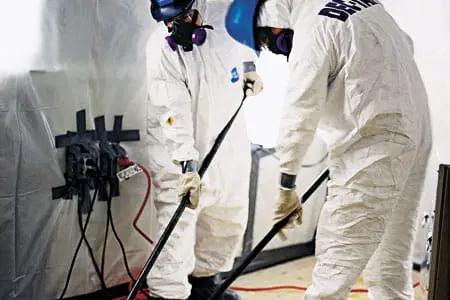Mold and asbestos are two of the most common and hazardous environmental hazards in homes and commercial buildings. Both can have serious health consequences if not addressed properly. Whether you’re renovating, buying an older property, or dealing with unexpected water damage, understanding how to identify and remove these hazards is critical for safety and compliance with Canadian regulations.
In this comprehensive guide, you’ll learn how to identify mold and asbestos, the risks associated with exposure, the safe removal process, and why relying on a certified service like Kleen Condition is essential for effective and compliant remediation.
- Understanding Mold and Its Risks
Mold is a type of fungus that grows in damp environments. It can appear on walls, ceilings, flooring, and behind drywall or insulation. Mold thrives where moisture is present, and left untreated, it can cause significant property damage and health issues.
1.1 Health Risks of Mold
Exposure to mold can result in:
- Allergic reactions such as sneezing, runny nose, and itchy eyes
- Respiratory issues, including asthma attacks and chronic coughing
- Skin irritation and rashes
- Long-term health complications for vulnerable populations, including children, seniors, and immunocompromised individuals
1.2 Signs of Mold Infestation
Common indicators of mold include:
- Musty odors
- Visible black, green, or white spots on surfaces
- Water damage or discoloration on walls and ceilings
- Peeling paint or wallpaper
- Condensation build-up in humid areas
Recognizing these signs early allows for faster remediation and prevents extensive damage.
- Understanding Asbestos and Its Dangers
Asbestos is a naturally occurring mineral that was widely used in construction materials for its fire-resistant and insulating properties. Although it is now banned in Canada, many older homes and buildings still contain asbestos in materials such as:
- Ceiling tiles
- Insulation
- Flooring
- Roofing shingles
- HVAC ducts and pipes
2.1 Health Risks of Asbestos
When asbestos fibers are disturbed and inhaled, they can cause severe health problems, including:
- Asbestosis (scarring of lung tissue)
- Lung cancer
- Mesothelioma (a rare, aggressive cancer)
- Chronic respiratory issues
Asbestos is particularly dangerous because symptoms often appear decades after exposure.
2.2 Identifying Asbestos
Identifying asbestos requires professional testing, as it cannot be confirmed through visual inspection alone. If your property was built before the 1990s, it is advisable to conduct a thorough inspection before renovation or demolition.
- Mold and Asbestos Removal: Why Professional Services Are Essential
Attempting to remove mold or asbestos without proper equipment and training can worsen contamination, spread hazardous fibers, and pose severe health risks. Certified remediation services like Kleen Condition ensure safe and effective removal.
3.1 Proper Equipment and Safety Gear
Professionals use:
- Personal protective equipment (PPE)
- HEPA-filtered vacuums
- Specialized containment barriers
- Negative air pressure systems
These tools prevent the spread of spores or asbestos fibers during removal.
3.2 Compliance with Regulations
Certified services adhere to Ontario regulations for environmental safety, including:
- Ontario Ministry of Labour (MOL) safety standards
- Canadian Environmental Protection Act (CEPA) requirements
- Proper disposal procedures for hazardous waste
3.3 Thorough Inspection and Testing
A complete remediation begins with a detailed inspection and laboratory testing to identify the type and extent of contamination.
- Steps Involved in Mold Removal
Professional mold remediation involves several critical steps:
4.1 Assessment
Technicians conduct a visual inspection and moisture testing to locate mold growth. Air quality tests determine the type and concentration of spores.
4.2 Containment
Affected areas are sealed off to prevent spores from spreading to other parts of the property.
4.3 Removal
Mold-infested materials, such as drywall, insulation, or carpets, are carefully removed and disposed of according to safety regulations.
4.4 Cleaning and Disinfection
Surfaces are scrubbed with antimicrobial solutions to eliminate remaining spores. HEPA vacuums capture airborne particles.
4.5 Drying and Moisture Control
Proper drying prevents recurrence. Technicians may install dehumidifiers or improve ventilation.
4.6 Final Testing
Air quality and surface testing ensure that mold has been effectively removed.
- Steps Involved in Asbestos Removal
Asbestos removal requires meticulous care and adherence to safety protocols:
5.1 Inspection and Sampling
Certified professionals take samples for laboratory testing to confirm the presence of asbestos.
5.2 Containment
The area is sealed using plastic sheeting and negative air pressure units to prevent fibers from spreading.
5.3 Removal
Asbestos-containing materials are carefully removed, wetting them to reduce dust. Special tools and techniques ensure minimal fiber release.
5.4 Cleaning and Decontamination
The area is cleaned using HEPA-filtered equipment, and workers follow strict decontamination procedures before exiting the site.
5.5 Disposal
Asbestos waste is transported to licensed disposal facilities according to Canadian regulations.
5.6 Clearance Testing
Air testing confirms the area is safe for occupancy after removal.
- Common Mistakes to Avoid During Mold and Asbestos Removal
Attempting DIY removal can be hazardous. Common mistakes include:
- Ignoring the extent of contamination: Partial cleanup can leave spores or fibers behind, leading to recurrence.
- Not using PPE: Exposure to spores or asbestos fibers can cause serious health issues.
- Improper disposal: Discarding hazardous materials in regular trash can harm the environment and violate regulations.
- Delaying remediation: Waiting allows mold to spread or asbestos fibers to accumulate, increasing risks and costs.
- Tips for Preventing Mold Growth
Prevention is always better than remediation. Key strategies include:
- Fix leaks promptly to prevent moisture accumulation
- Maintain proper ventilation in bathrooms, kitchens, and basements
- Use dehumidifiers in humid areas
- Regularly clean and inspect HVAC systems
- Avoid carpeting in areas prone to dampness
These steps minimize the likelihood of mold growth and protect indoor air quality.
- Tips for Preventing Asbestos Exposure
While you cannot remove asbestos yourself safely, you can take measures to prevent exposure:
- Do not disturb materials suspected to contain asbestos
- Avoid drilling, sanding, or cutting in areas with asbestos-containing materials
- Schedule professional inspection before renovations or demolition
- Seal or encapsulate asbestos-containing materials temporarily until removal
Following these tips ensures safety for both homeowners and occupants.
- Choosing the Right Mold and Asbestos Removal Service
Selecting a certified provider is crucial for effective remediation.
9.1 Certifications
Ensure the company has:
- Ministry of Labour-approved certifications
- Environmental safety training
- Licensed disposal partnerships
9.2 Experience
Look for a provider with proven experience in both residential and commercial properties.
9.3 Comprehensive Services
A full-service provider should offer:
- Inspection and testing
- Remediation and removal
- Post-remediation clearance
- Ongoing consultation and support
9.4 Transparent Pricing
Reputable companies provide detailed quotes, outlining materials, labor, and any additional costs.
9.5 Customer Reviews and Reputation
Positive reviews and local recognition demonstrate reliability, professionalism, and quality service.
A trusted provider like Kleen Condition ensures safe, thorough, and compliant remediation for properties across Mississauga and Ontario.
- Why Professional Remediation Protects Your Health and Property
Professional mold and asbestos removal not only safeguards your health but also:
- Preserves property value
- Reduces long-term repair costs
- Prevents legal liability in commercial settings
- Maintains compliance with local regulations
DIY attempts or unlicensed services may put occupants at risk and fail to fully remove hazards.
- Preparing for Mold and Asbestos Remediation
Before technicians arrive:
- Clear personal items from affected areas
- Ensure pets and children are safely relocated
- Notify neighbors if remediation involves shared spaces
- Follow all pre-remediation instructions from the service provider
Proper preparation ensures a smooth, efficient, and safe process.
- Post-Remediation Care and Monitoring
After mold or asbestos removal:
- Inspect areas periodically for moisture or damage
- Maintain ventilation and humidity control
- Schedule regular inspections if the property is older or prone to mold
These steps help prevent recurrence and ensure a safe living or working environment.
- Final Thoughts: Choose Certified Experts for Mold and Asbestos Removal
Mold and asbestos are serious environmental hazards that require professional attention. Attempting removal without proper training, equipment, and certification can put your health and property at risk.
Working with a certified, experienced provider like Kleen Condition guarantees:
- Safe and effective removal
- Compliance with Ontario regulations
- Accurate testing and inspection
- Long-term prevention and monitoring
Whether you’re addressing water damage, renovating an older building, or ensuring safety for tenants or family members, professional remediation is essential. Prioritizing certified services ensures peace of mind, a healthy indoor environment, and protection of your investment.


